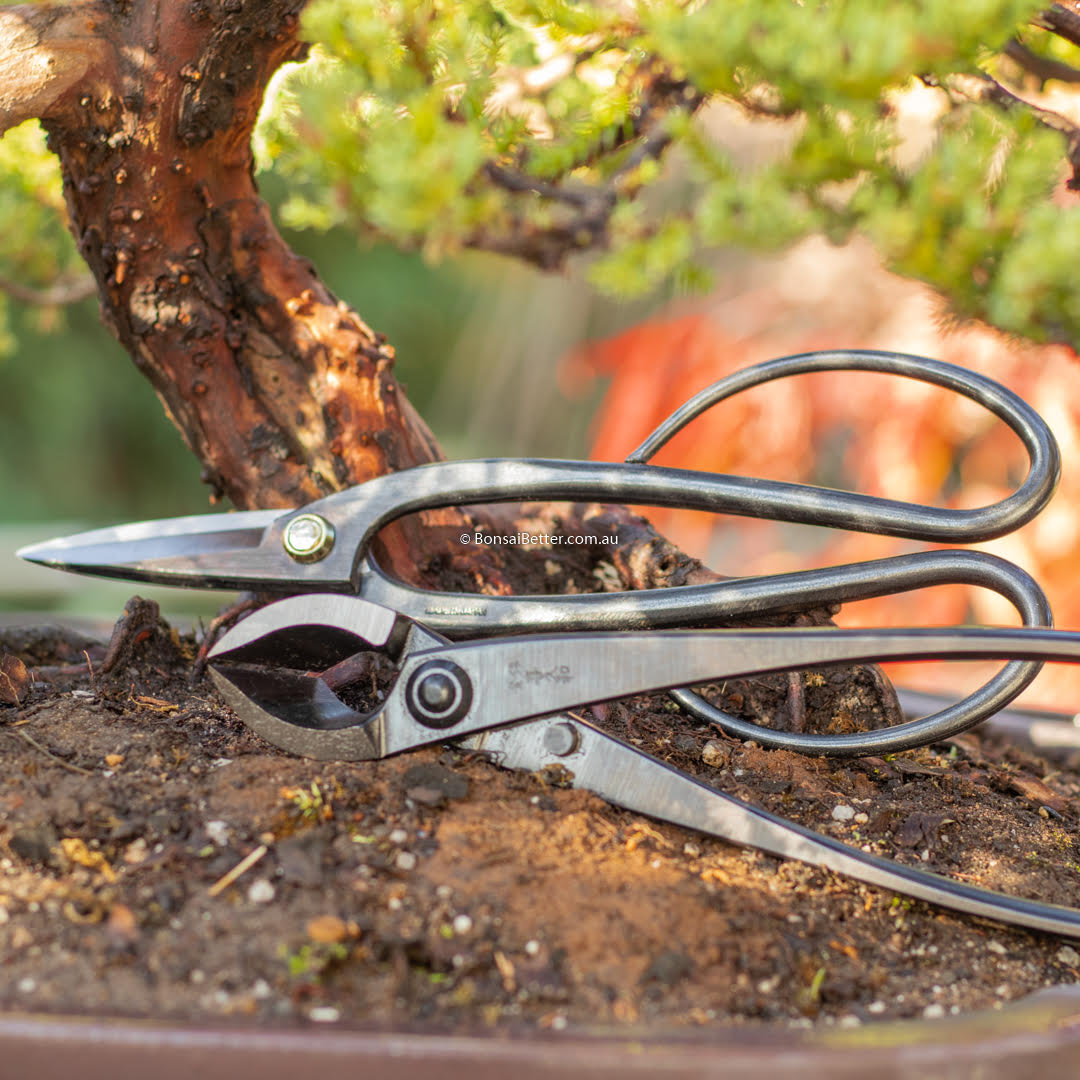
When it comes to bonsai tools, one question that often pops up is: Which material is best? Stainless steel or carbon steel? Or, do you mix both? Bonsai practitioners seem to have varied opinions on this, and as with many aspects of bonsai, there’s no definitive answer just personal preferences and needs. But let’s have a closer look at the two most popular materials for bonsai tools and explore their pros, cons, and what might work best for you.
Most bonsai tools, such as branch cutters, scissors/shears, jin pliers, and wire cutters, are made from stainless steel or carbon steel. Both materials offer unique benefits, and choosing the right one depends on your specific needs, budget, and how much care you’re willing to put into maintenance.
Stainless Steel
- Advantages:
- Rust & Corrosion Resistance: Stainless steel offers excellent resistance to rust and corrosion, which makes it ideal for working in wet, humid environments or for beginners who may not have the time or knowledge for proper tool care.
- Low Maintenance: Stainless steel tools are more resistant to rust, requiring less maintenance. After use, you can simply wash and dry them thoroughly. While not strictly necessary, applying a bit of camellia oil can offer extra protection.
- Disadvantages:
- Sharp Edge: While stainless steel can hold an edge, it is generally not as sharp or as long-lasting as carbon steel. You may need to sharpen these tools more frequently. Stainless steel bonsai tools are generally harder to sharpen than carbon steel tools, but it depends on the specific alloy and the hardness of the tool itself.
- Cost: Stainless steel tools are often more expensive to manufacture due to the material’s cost, making them pricier than carbon steel tools.
Carbon Steel
- Advantages:
- Sharper & More Durable: Carbon steel tools are known for their ability to retain a sharp edge. This makes them ideal for precise cutting and fine detailing, a key factor for serious bonsai enthusiasts.
- Ease of sharpening: Carbon steel tools are generally easier to sharpen compared to stainless steel tools, making them more convenient for frequent maintenance.
- Disadvantages:
- Rust: Carbon steel is more susceptible to rust, which can develop quickly if the tools aren’t properly cared for. After every use, they need to be dried thoroughly and oiled (e.g., with camellia oil) to prevent corrosion.
- Higher Maintenance: Due to their susceptibility to rust, carbon steel tools require more maintenance. Neglecting to dry or oil them properly can lead to damage over time.
What About Affordability?
When it comes to budget, carbon steel tools are generally more affordable than stainless steel, though the price can vary based on brand and craftsmanship. That said, high-quality bonsai tools are an investment that can last a lifetime if cared for properly.
While stainless steel tools tend to have a higher upfront cost, they can be more cost-effective in the long run because they require less maintenance.
Brand Recommendations
Chinese Bonsai Tools
Ryuga offers some of the best quality Chinese-made bonsai tools on the market. These tools combine Japanese-grade craftsmanship with more affordable production costs, thanks to manufacturing in China. As a result, Ryuga tools are budget-friendly without sacrificing performance or durability.
Japanese Bonsai Tools
Kikuwa based in Sanjo City, Niigata Prefecture Japan, is renowned for producing some of the finest bonsai tools in the world. Sanjo has a long history of cutlery craftsmanship, and Kikuwa collaborates with local artisans to offer tools that meet the needs of bonsai enthusiasts of all skill levels. Kikuwa tools are well-regarded for their quality and precision.
Both Ryuga and Kikuwa offer both carbon steel and stainless steel tools, with options that fit different price points. Whether you go for a more affordable option from Ryuga or a premium Kikuwa tool, both brands deliver quality craftsmanship.
What’s the Verdict?
So, which material is better for your bonsai tools stainless steel or carbon steel? The answer depends on what you value most.
- For Beginners or Low-Maintenance Enthusiasts: If you're just starting out or prefer not to worry about tool maintenance, stainless steel tools are likely the better choice. They're durable, rust-resistant, and require minimal upkeep.
- For Experienced Bonsai Practitioners: If you're looking for sharpness and precision, and you don’t mind putting in a little extra work to maintain your tools, carbon steel could be the way to go.
Many bonsai enthusiasts, myself included, use a mix of both. I use stainless steel tools for tasks like repotting because they’re easy to clean and maintain. After a repotting session, I just hose them off, dry them with a rag, and apply a bit of camellia oil to keep them in top shape.
For tasks requiring precision, like detailed trimming, I reach for carbon steel tools. But I make sure to dry and oil them thoroughly after each use to prevent rust.
For optimal performance, always use bonsai tools within their intended capabilities regardless of brand, country of origin, or whether they are made from stainless steel or carbon steel.
Final Thoughts
At the end of the day, choosing the right material for your bonsai tools comes down to your personal preference, budget, and how much time you're willing to spend on maintenance. Whether you prefer the low-maintenance nature of stainless steel or the sharp, long-lasting edge of carbon steel, both materials have their place in a well-equipped bonsai toolkit.
Have any questions or would like advice on bonsai tools? Feel free to contact us, or check out our collection of high-quality bonsai tools here. Shop Bonsai Better

